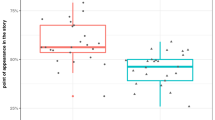Abstract
Three different ways have been selected for analyzing a story's structure, each focusing on different types of information. (a) Episodic or story grammar approaches stories as problem-solving episodes, emphasizing goals and activities to achieve them. (b) Labov's high point structure emphasizes affective information and sees stories as organized around emotional high points or crisis events. (c) Deese's dependency analysis emphasizes linguistic complexity and, in particular, the way propositions are related to each other through a relationship of either coordination or subordination. Stories were scored according to how well they realized good structure in each system, and the three scoring systems were relatively independent of each other. Adults were asked to rate 3-to 9-year old children's personal narratives in terms of how good a story each was, and their ratings were compared to how the stories were scored in terms of all three systems. None of the systems completely explained the subjective quality ratings; rather, all three seemed to contribute in different ways to subjects' ratings, with the best narratives generally deemed sophisticated and complex in at least two of the three systems.
Similar content being viewed by others
References
Black, J. B., & Wilensky, R. (1979). An evaluation of story grammars.Cognitive Science, 3, 213–230.
Brown, R. (1973).A first language. Cambridge: Harvard University Press.
Christiensen, F., & Christiensen, B. (1976).A new rhetoric. New York: Harper & Row.
Deese, J. (1983).Thought into speech: Psychology of a language. Englewood Cliffs, New Jersey: Prentice-Hall.
Glenn, C. (1978). The role of episodic structure and of story length on children's recall of single stories.Journal of Verbal Learning and Verbal Behavior, 17, 229–247.
Glenn, C., & Stein, N. (1980). Syntactic structures and real world themes in stories generated by children (Technical report). Urbana: University of Illinois, Center for the Study of Reading.
Jenkins, J. J. (1974). Remember that old theory of memory? Well, forget it.American Psychologist, 785–795.
Kintsch, W., & Greene, E. (1978). The role of culture-specific schemata in the comprehension and recall of stories.Discourse Processes, 1, 1–13.
Labov, W. (1972)Language in the inner city. Philadelphia: University of Pennsylvania Press.
Labov, W., Cohen, P., Robins, C., & Lewis, J. (1968).A study of the non-standard English of Negro and Puerto Rican speakers in New York City (Vol. 2) (Cooperative Research Project No. 3288). Washington, D.C.: Office of Education.
Labov, W., & Waletzky, J. (1967). Narrative analysis: Oral versions of personal experience. In J. Helm (Ed.)Essays on the verbal and visual arts. Seattle: University of Washington Press.
Mandler, J. M. (1978). A code in the node: The use of a story schema in retrieval.Discourse Process, 1, 14–35.
Mandler, J. M., & Johnson, N. (1977). Remembrance of things parsed: Story structure and recall.Cognitive Psychology, 9, 111–151.
Mandler, J. M., Scribner, S., Cole, M., & DeForest, M. (1980). Cross-cultural invariance in story recall.Child Development, 51, 19–26.
Peterson, C., & McCabe, A. (1983)Three ways of looking at a child's narrative: A psycholinguistic analysis. New York: Plenum.
Pollard-Gott, L., McCloskey, M., & Todres, A. (1979). Subjective story structure.Discourse Processes, 2, 251–281.
Rumelhart, D. E. (1975). Notes on a schema for stories In D. G. Bobros & A. Collins (Eds.),Representation and understanding: Studies in cognitive science. New York: Academic Press.
Rumelhart, D. E. (1977). Understanding and summarizing brief stories. In D. LaBerge & S. J. Samuels (Eds.),Basic processes in reading: Perception and comprehension. Hillsdale, New Jersey: Erlbaum.
Schank, R., & Abelson, R. (1977).Scripts, plans, goals, and understanding. Hillsdale, New Jersey: Erlbaum.
Stein, N. L., & Glenn, C. (1979). An analysis of story comprehension in elementary school children. In R. Freedle (Ed.),New directions in discourse processing. Hillsdale, New Jersey: Ablex.
Thorndyke, P. W. (1977). Cognitive structures in comprehension and memory of narrative discourse.Cognitive Psychology, 9, 77–110.
van Dijk, T. A., & Petoefi, J. (Eds.) (1977).Grammars and description: Studies in text theory and text analysis. Netherlands: DeGruytier.
Author information
Authors and Affiliations
Additional information
The authors wish to acknowledge their great debt to James Deese and Christine Glenn. This research was supported by the National Sciences and Engineering Research Council of Canada Grant A-7911 to Carole Peterson.
Rights and permissions
About this article
Cite this article
McCabe, A., Peterson, C. What makes a good story. J Psycholinguist Res 13, 457–480 (1984). https://doi.org/10.1007/BF01068179
Accepted:
Issue Date:
DOI: https://doi.org/10.1007/BF01068179




